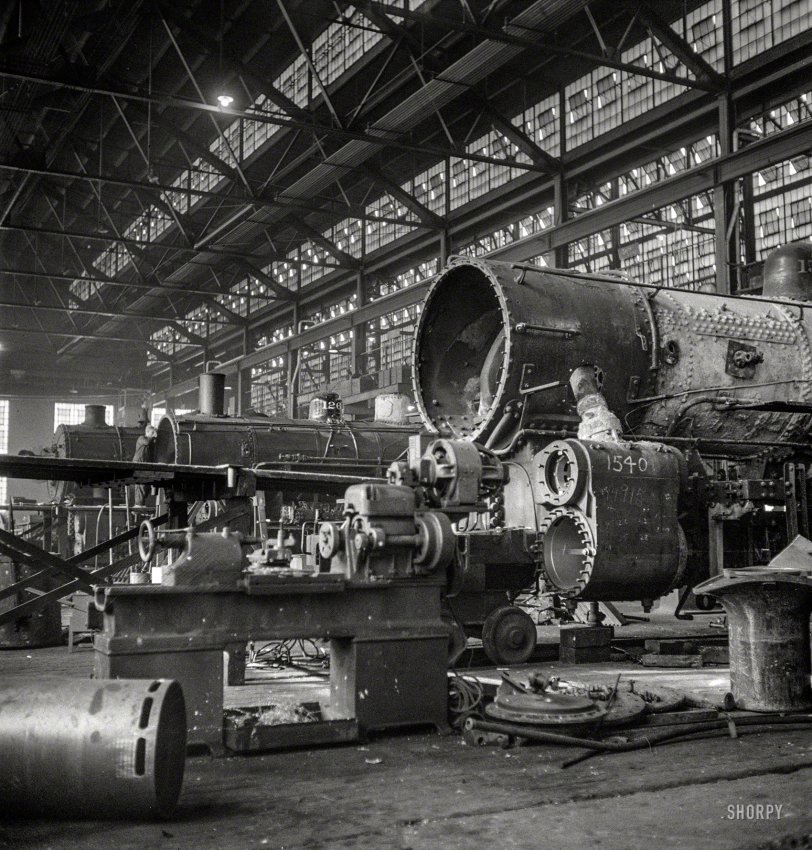


Framed or unframed, desk size to sofa size, printed by us in Arizona and Alabama since 2007. Explore now.
Shorpy is funded by you. Patreon contributors get an ad-free experience.
Learn more.

- Illuminate us
- I remember it well
- I can't prove it
- Complicated then, forgotten now
- Bryan-Stevenson
- Skinny is as skinny does
- How do you rest in peace
- Riding the footboards
- Alas, hidden from view
- Baldwin Diesels
- Exclusive pump
- Bananas, Oysters and Smokey Joe
- Details, Details
- What's that building to the left of the tower?
- Coal Barges
- Bromo-Seltzer
- Inner harbor
- The Basin
- What a headache!
- Giant stepladder?
- Yeah, it was cold
- Love those coats
- Link & Pin Days Remnant
- Baldwin 62303
- Baldwin VO-1000
- Cold
- No expense spared
- Tough Guys
- What's your hurry, where's your hat?
- Sheriff's Signature
Print Emporium
In for Overhaul: 1942

December 1942. "Chicago, Illinois. In the Chicago & North Western locomotive repair shops." Photo by Jack Delano, Office of War Information. View full size.
Thanks LarryDoyle
Good info on locomotives! How they worked on the inside was always a mystery to me.
Overhaul Cycles
Steam locomotives required a lot of time in the shops. Inspections were made daily and small repairs and adjustments were made daily to keep the engines in proper tuneup. All of this could be done while keeping the engine hot.
Every 31 days the fire was put out and the boiler was required to be drained, cleanout plugs removed and the interior of the boiler washed out with high pressure water jets. Certain appliance had to be removed, disassembled, cleaned, and reinstalled.
Every 92 days additional inspections were required, and other work, primarily air components, were removed and rebuilt.
There was also a one year cycle for certain other repairs.
But the big one every 5 years, as shown in this photo, concerned major boiler work, and disassembly of the running gear. It could take an engine out of service for a couple weeks. The engine was lifted off its wheels, and every component that could be removed was disassembled, inspected, tested, and completely rebuilt as necessary. In the foreground we see a cylinder liner in left foreground, and the stack casting on the right. A portable machine was set up in front of the cylinders for re-boring the casting to receive new liners.
Boilers had their superheaters removed and all flues taken out. Inspectors climbed inside and cleaned out accumulated scale, and carefully examined inside and out for hints of excessive corrosion or cracking. If necessary complete boilers could be removed from the running gear and frames, and major boiler repairs made.
Very labor intensive and expensive, so the railroads were more than happy to switch to diesel electric locomotives when they became available.
Overhaulin'
How often did these locomotives have to be overhauled or rebuilt? I am thinking in terms of automobiles, which need an engine overhaul at 100,000 to 200,000 miles. (My mind is stuck on the 1960s cars.)
But locomotives -- what determined their timeframe?
Also I live near the Union Pacific rail yards in Roseville, California, and I can hear when a diesel needs repair. Talk about LOUD.
























On Shorpy:
Today’s Top 5